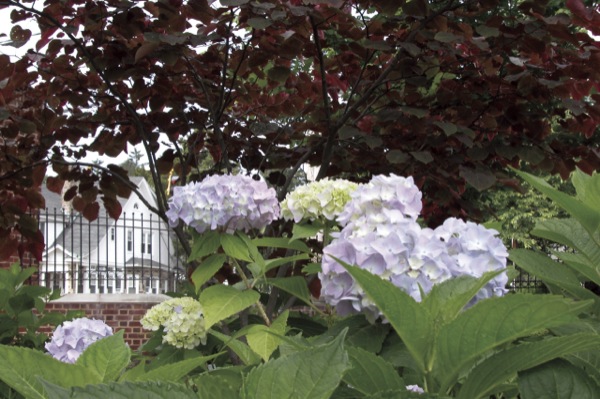
April 25-26: UDBG plant sale
UD Botanic Gardens announce annual benefit plant sale
11:15 a.m., March 31, 2014--The 22nd annual University of Delaware Botanic Gardens Benefit Plant Sale will be held on Friday and Saturday, April 25-26, on the South Campus in Newark.
The sale will be held from 3-7 p.m. Friday and from 9:30 a.m.-4 p.m. Saturday – the latter in conjunction with Ag Day -- in the fenced area across from Fisher Greenhouse. Admission is free.
Events Stories
June 5: Blue Hen 5K
June 6-9: Food and culture series
Those with interest can view the plant sale catalog at the UDBG website to see an array of summer’s grande dames of horticulture -- the hydrangea, a prime selection of magnolias, maples and iris, along with hundreds of additional select treasures.
UDBG Friends enjoy an exclusive day to shop at the sale on Thursday, April 24, from 3-7 p.m. To enjoy other exclusive member benefits, join the Friends online or contact Melinda Zoehrer at 302-831-0153 or BotanicGardens@udel.edu.
Hydrangeas featured
The featured plants, hydrangeas, though a small portion of the many ornamental shrubs available to modern gardeners, embody all the best attributes of horticulture as a hobby and, for some, an obsession. This beautiful group of plants exhibits a stunning diversity of species and cultivated varieties that satisfy a wide range of tastes and garden settings. All members of the genus share a common name, but in some cases the similarities end there.
The impressive floral prowess of many hydrangeas is arguably their most exciting and endearing feature. Interestingly, the impressive diversity of the family means this characteristic is itself subject to a number of different factors. These traits, long admired by hydrangea aficionados, include flower color, size, shape and the season in which they are at their best.
Next, the specific growth habit, growth rate and mature size of the various hydrangeas dictate their appropriate landscape placement. Finally, their varying foliage characteristics, from spring through fall, combine to provide a plethora of exciting options. When it comes to hydrangeas, there is truly something for everyone.
The genus hydrangea consists of over 70 species worldwide, but the best choices for Mid-Atlantic gardens can be narrowed down to five main groups. Each group consists of one or more "hallmark" species that exemplify their prime ornamental features and any number of named varieties, known as cultivars.
The first four groups consist of shrubby plants and include Smooth hydrangea (H. arborescens), Oakleaf hydrangea (H. quercifolia), Panicle hydrangea (H. paniculata) and the classic lacecap and mophead types (H. macrophylla and H. serrata), whose colorful blooms have graced gardens for centuries.
The fifth and final group includes the handsome pair of vines known as Climbing hydrangea (H. anomala ssp. petiolaris) and its cousin the Japanese hydrangea vine (Schizophragma hydrangeoides).
Each group offers its own personality, distinct ornamental attributes and respective place in the garden.
About the hydrangea groups
First, Smooth hydrangea is a native shrub found in shady forest nooks throughout the Mid-Atlantic and Southern states. It becomes a prominent garden feature each May as large creamy flower clusters cover its leafy framework.
This plant, perhaps best known by the popular variety Annabelle, often droops to the ground under the weight of its floral might. Dedicated breeding work in recent years has led to the availability of pink flowered types such as Invincibelle Spirit and Bella Anna.
The second group also consists of a shrubby denizen of the southeastern United States. Oakleaf hydrangea is so-named for its deeply cut foliage that mimics the familiar look of many oak tree (Quercus spp.) leaves. This fascinating textural attribute alone would be a great reason to grow this species, however it also offers an excellent display of white, conical flower panicles in late spring.
Fall brings yet another season of interest as the leaves take on gorgeous shades of burgundy, orange and scarlet. Many selections have been made for flower size and growth habit over the years. These even include an intriguing cultivar with glowing chartreuse foliage known as Little Honey.
The next group of hydrangeas is one that has enjoyed renewed popularity in recent years. The Panicle, or PeeGee hydrangea, is a feature of older farmsteads and the confines of "grandma's garden." It is an Asian import that became quite popular during Victorian times. Athletic in its physiology, it is a plant of impressive growth rate that springs into aesthetic action during mid to late summer.
Prominent white flower panicles decorate the landscape at a time when most other trees and shrubs have faded into the background. Interest in this old favorite has been rekindled by newer varieties bred for compactness and reduced size at maturity -- perfect qualities for today's smaller gardens.
The exquisite, showy blooms of the fourth group represent the quintessential concept of the genus hydrangea. Bigleaf hydrangea (H. macrophylla) and Mountain hydrangea (H. serrata) are closely related species that serve similar ornamental roles. The first species has been cultivated for centuries and offers flowers in either a "mophead" (ball-shaped) appearance or a "lacecap" (flat or horizontal) arrangement. Cultivars have been bred in a dizzying array of color combinations, including white, pink, red, blue and purple.
Mountain hydrangea differs mainly in its smaller stature and proclivity toward the "lacecap" floral type. These species are the hydrangeas famous for exhibiting varying flower color depending on soil chemistry. Acid soils (higher pH) encourage flowers that tend toward blue, while neutral to basic soils (lower pH) lead to pink flowers. Newer reblooming varieties such as Endless Summer all but guarantee a captivating floral show from spring through fall.
Finally, two additional species typify a decidedly non-traditional concept of hydrangeas. Both are climbing vines quite adept at scrambling up walls, fences and even the sides of buildings. Though differing in small fairly obscure botanical traits, Climbing hydrangea and the Japanese hydrangea vine are used similarly in the landscape. Both offer lacey white flower clusters in late spring and add a new dimension to how hydrangeas beautify our gardens.
UD Botanic Gardens
The UD Botanic Gardens are open year-round to provide ideas and inspiration, or for a quiet stroll.
UDBG contributes to an understanding of the relationships between plants and people through education, research, cooperative extension, and community support.
Article by Jason Veil, UDBG curatorial graduate teaching assistant








